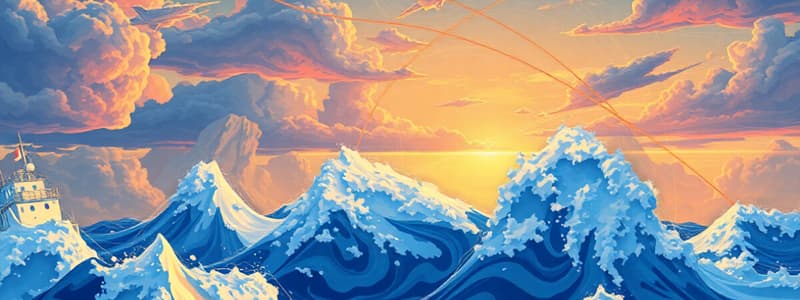Podcast
Questions and Answers
Besides marine radio, what other technologies allow access to weather information while at sea?
Besides marine radio, what other technologies allow access to weather information while at sea?
NAVTEX, INMARSAT, HF/Single Sideband radio, and Satellite phones
Why is accessing weather information via the internet valuable for mariners?
Why is accessing weather information via the internet valuable for mariners?
It provides a wide range of weather information, forecasts, and weather charts which users can use in planning voyages.
Before digital methods, how were weather charts transmitted internationally to ships?
Before digital methods, how were weather charts transmitted internationally to ships?
Facsimile machines transmitted weather charts internationally via HF radio.
What types of meteorological services are provided by Metoffice?
What types of meteorological services are provided by Metoffice?
Describe the composition of meteorological codes.
Describe the composition of meteorological codes.
A weather observation records a total cloud amount of 8 oktas. According to the provided weather codes, what letter is used to represent this State of Sky?
A weather observation records a total cloud amount of 8 oktas. According to the provided weather codes, what letter is used to represent this State of Sky?
If a mariner observes distant lightning but the sound is too far away to reach the observer, what Beaufort letter is used to record this phenomenon?
If a mariner observes distant lightning but the sound is too far away to reach the observer, what Beaufort letter is used to record this phenomenon?
What Beaufort letter is used to record when the state of the sky is uniform thick layer of cloud, completely covering the sky?
What Beaufort letter is used to record when the state of the sky is uniform thick layer of cloud, completely covering the sky?
Besides hail, what other forms of precipitation are associated with the number (5)?
Besides hail, what other forms of precipitation are associated with the number (5)?
What does the Beaufort letter 'm' represent in atmospheric obscurity, and what are the visibility and relative humidity conditions?
What does the Beaufort letter 'm' represent in atmospheric obscurity, and what are the visibility and relative humidity conditions?
Explain how wind direction and speed are indicated on a weather station plot.
Explain how wind direction and speed are indicated on a weather station plot.
What does the abbreviation 'PPP' stand for in weather observations, and in what units is it measured?
What does the abbreviation 'PPP' stand for in weather observations, and in what units is it measured?
If 'TaTa' is recorded as 18°C, what weather element does 'TaTa' represent?
If 'TaTa' is recorded as 18°C, what weather element does 'TaTa' represent?
What does the weather code 'dd' represent in weather observations?
What does the weather code 'dd' represent in weather observations?
In last 3 hours, pressure is falling 0.5mb. What code group would you use to represent this?
In last 3 hours, pressure is falling 0.5mb. What code group would you use to represent this?
Describe how sea-level pressure is plotted on a weather station plot.
Describe how sea-level pressure is plotted on a weather station plot.
According to Beaufort Letters system, what is the order of recording the weather phenomena?
According to Beaufort Letters system, what is the order of recording the weather phenomena?
What does the Beaufort letter 'Y' represent in other phenomena and what is its condition?
What does the Beaufort letter 'Y' represent in other phenomena and what is its condition?
What does the Beaufort letter 'X' represent in other phenomena?
What does the Beaufort letter 'X' represent in other phenomena?
Flashcards
Internet Weather Sources
Internet Weather Sources
Accesses weather data through Internet cafes, WiFi, cell phones, satellite phones, marine HF, and amateur radio.
Facsimile machines definition
Facsimile machines definition
Machines used to internationally transmit weather charts via High Frequency (HF) radio.
Metoffice Services
Metoffice Services
The services provided by Metoffice are providing information on the climatology of oceanic and coastal areas, and provide ground-truth for satellite observations, Ice Analysis, Forecasts and Iceberg Reports Tide Predictions, Observations, and Storm Surge Forecast
Meteorological codes
Meteorological codes
Signup and view all the flashcards
Beaufort Letters
Beaufort Letters
Signup and view all the flashcards
State of Sky - 'b'
State of Sky - 'b'
Signup and view all the flashcards
State of Sky - 'bc'
State of Sky - 'bc'
Signup and view all the flashcards
State of Sky - 'c'
State of Sky - 'c'
Signup and view all the flashcards
State of Sky - 'o'
State of Sky - 'o'
Signup and view all the flashcards
Thunderstorm code 'l'
Thunderstorm code 'l'
Signup and view all the flashcards
Thunderstorm code 't'
Thunderstorm code 't'
Signup and view all the flashcards
Thunderstorm/code 't!'
Thunderstorm/code 't!'
Signup and view all the flashcards
Description of drizzle
Description of drizzle
Signup and view all the flashcards
Gale
Gale
Signup and view all the flashcards
Storm
Storm
Signup and view all the flashcards
Description of Fog
Description of Fog
Signup and view all the flashcards
Description of Wet Fog
Description of Wet Fog
Signup and view all the flashcards
Description of Shallow Land/Sea Fog
Description of Shallow Land/Sea Fog
Signup and view all the flashcards
Description of Dust/Sandstorm
Description of Dust/Sandstorm
Signup and view all the flashcards
Wind plotting direction
Wind plotting direction
Signup and view all the flashcards
Study Notes
- Weather Services for Shipping per STCW Table A-II/1
Sources of Weather Information
- Marine VHF/MF Radio: Used for local broadcasts.
- NAVTEX and INMARSAT: Provides text-based weather and navigational warnings.
- HF/Single Sideband Radio: Useful for longer-range forecasts and charts.
- Public service radio: Broadcasts weather information.
- Internet: Access to a wide range of weather data via WiFi, cell, or satellite phone, even HF amateur radio.
- Telephone: Can be used to access weather information.
- Media: Traditional sources like TV and radio.
Internet Weather Information
- The internet provides access to weather information in internet cafes, via WiFi, cell phones, satellite phones, and marine HF/amateur radio.
- Using internet based weather services is valuable when in harbor, at anchor, or at sea.
Transmitting Weather Charts
- Facsimile machines transmitted weather charts internationally via HF radio.
- Radio transmission of weather charts is flexible for marine and aviation users, providing weather information and forecasts for voyage planning.
Weather Services Provided by Metoffice
- Metoffice provides information on oceanic and coastal climatology.
- Metoffice provides ground-truth for satellite observations.
- Metoffice services include ice analysis, forecasts, and iceberg reports.
- Metoffice provides tide predictions and observations
- Metoffice provides storm surge forecasts.
Recording and Reporting Weather Observations
- Meteorological codes are composed of values defined in tables, referenced to positions within strings of information.
- Defined values make up a code form, and binary codes are made up of groups of letters.
- Code groups represent meteorological or other geophysical elements.
- Different code forms represent different observation types or products.
Weather as Observed: Code Groups
- N: Total amount of cloud in oktas (eighths).
- TT: Dry-bulb air temperature in degrees Celsius.
- ww: Present weather.
- dd: Wind direction in degrees.
- ff: Wind speed in knots.
- W: Visibility in meters or kilometers.
- TaTa: Dew-point temperature in degrees Celsius.
- C or C: Type of low cloud.
- W.W.: Past weather.
- pppa or pppa: Pressure tendency and trend (black: rising, red: falling) in millibars.
- PPP: Atmospheric pressure in millibars.
- C or C: Type of medium cloud.
Beaufort Letters - A System for Weather Reporting
- Beaufort Letters are a system using letters and numbers to indicate various weather types.
- Beaufort Letters are used to record phenomena at a particular time.
- Standard reporting order includes:
- State of Sky
- Thunderstorm (if present)
- Precipitation (if present)
- Atmospheric obscurity (if present)
- Any other phenomena
State of the Sky Codes
- b: Total cloud amount 0 to 2 oktas (eighths covered).
- bc: Total cloud amount 3 to 5 oktas.
- c: Total cloud amount 6 to 8 oktas.
- o: Uniform thick layer of cloud covers the sky (8 oktas) with no gaps, mainly used with St, Ns and thick As.
Thunderstorm/Allied Phenomena Codes
- l: Distant lightning; storm too far for sound.
- t: Thunder heard; no lightning seen.
- t!: Thunderstorm.
Precipitation Codes
- d: Drizzle, freezing drizzle (uniform precipitation with small drops < 0.5 mm diameter).
- dr: Drizzle and rain mixed.
- h: Hail, small hall, snow pellets, diamond dust, ice pellets.
- hr: Hail and rain mixed.
- hs: Hail and snow mixed.
- r: Rain, freezing rain (liquid water particles > 0.5 mm diameter or smaller widely scattered drops).
- rs: Rain and snow mixed, or partially melted snow (sleet).
- s: Snowflakes.
- sh: Snow grains ('granular snow').
Other Phenomena Codes
- e: Wet air, without rain, snow etc. falling.
- g: Gale (mean speed 34–47 knots over a 10 minute period).
- G: Storm (mean speed 48 knots or more over a 10 minute period).
- i: Intermittent (used with precipitation and fog).
- j: Phenomenon within site but not at the location of the observer.
- kq: Line Squall.
- p: Shower – see notes against precipitation for usage.
- u: Ugly, threatening sky (in addition to bc/c/o etc.).
- w: Dew deposit (make sure that "dew" is really being deposited, and not just 'guttation' water extruded from plant leaf surfaces on some cold nights.).
- x: Hoar frost deposit.
- y: Dry air – less than 60% relative humidity.
Atmospheric Obscurity Codes
- f: Fog, ice fog (visibility < 1000 m).
- fe: Wet fog (visibility < 1000 m).
- fg/fs: Shallow land/sea fog (visibility above the fog >=1 km).
- F: Fog, Ice fog ^(visibility < 200 m).
- ks: Drifting or blowing snows.
- kz: Dust or sandstorm (visibility < 1000 m).
- m: Mist (visibility >=1 km) (Relative Humidity >~95% ).
- z: Haze.
Weather Station Plot
- Wind: Plotted with the outer end of the symbol pointing to direction wind is blowing from, speed determined from flags and lines
- Sea-level pressure: Plotted in tenths of millibars, with leading 10 or 9 omitted.
- Pressure trend: Has two components: a number and a symbol indicating pressure change in the last three hours.
Studying That Suits You
Use AI to generate personalized quizzes and flashcards to suit your learning preferences.




